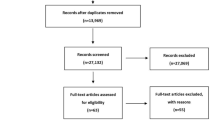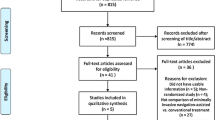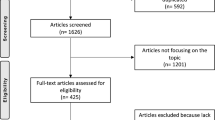Abstract
Background
Concerns have been raised regarding minimally invasive surgery (MIS) and its possible effect on postoperative functional recovery, complications, and survival rate after TKA.
Questions/purposes
We specifically asked whether MIS TKA would be associated with (1) increased operative time, (2) reduced blood loss, (3) shortened hospital stay, (4) faster recovery of ROM, (5) higher knee scores, (6) inferior component positioning, and (7) increased complications.
Methods
We performed a systematic literature search of randomized controlled trials between minimally invasive and standard approaches in TKA that compared operative time, blood loss, ROM, knee scores, component positioning, and complications. We conducted a systematic review and meta-analysis of 13 trials published from 2007 to 2009 of MIS versus standard TKA.
Results
Patients in the MIS group had longer operating times (10–19 minutes). Mean Knee Society scores were better after MIS than after the standard procedure at 6 and 12 weeks postoperatively, but not after 6 months. Improvement in ROM occurred more rapidly in the MIS group 6 days after TKA but later improvements are not clearly documented. We identified no differences between minimally invasive and standard approaches regarding the short-term overall complications and alignment of femoral and tibial components. However, wound healing problems and infections occurred more frequently in the MIS group.
Conclusions
MIS leads to faster recovery than conventional surgery with similar rates of component malalignment but is associated with more frequent delayed wound healing and infections. Potential benefits in long-term survival rate and functional improvement require additional investigation.
Level of Evidence Level II, therapeutic study (systematic review). See the Guidelines for Authors for a complete description of levels of evidence.



Similar content being viewed by others
References
Aglietti P, Baldini A, Giron F, Sensi L. Minimally invasive total knee arthroplasty: is it for everybody? HSS J. 2006;2:22–26.
Barrack RL, Barnes CL, Burnett RS, Miller D, Clohisy JC, Maloney WJ. Minimal incision surgery as a risk factor for early failure of total knee arthroplasty. J Arthroplasty. 2009;24:489–498.
Biasca N, Wirth S, Bungartz M. Mechanical accuracy of navigated minimally invasive total knee arthroplasty (MIS TKA). Knee. 2009;16:22–29.
Boerger TO, Aglietti P, Mondanelli N, Sensi L. Mini-subvastus versus medial parapatellar approach in total knee arthroplasty. Clin Orthop Relat Res. 2005;440:82–87.
Bonutti PM, Dethmers D, Ulrich SD, Seyler TM, Mont MA. Computer navigation-assisted versus minimally invasive TKA: benefits and drawbacks. Clin Orthop Relat Res. 2008;466:2756–2762.
Bonutti PM, Dethmers DA, McGrath MS, Ulrich SD, Mont MA. Navigation did not improve the precision of minimally invasive knee arthroplasty. Clin Orthop Relat Res. 2008;466:2730–2735.
Bullens PH, van Loon CJ, de Waal Malefijt MC, Laan RF, Veth RP. Patient satisfaction after total knee arthroplasty: a comparison between subjective and objective outcome assessments. J Arthroplasty. 2001;16:740–747.
Chin PL, Foo LS, Yang KY, Yeo SJ, Lo NN. Randomized controlled trial comparing the radiologic outcomes of conventional and minimally invasive techniques for total knee arthroplasty. J Arthroplasty. 2007;22:800–806.
Chotanaphuti T, Ongnamthip P, Karnchanalerk K, Udombuathong P. Comparative study between 2 cm limited quadriceps exposure minimal invasive surgery and conventional total knee arthroplasty in quadriceps function: prospective randomized controlled trial. J Med Assoc Thai. 2008;91:203–207.
Dalury DF, Dennis DA. Mini-incision total knee arthroplasty can increase risk of component malalignment. Clin Orthop Relat Res. 2005;440:77–81.
DerSimonian R, Kacker R. Random-effects model for meta-analysis of clinical trials: an update. Contemp Clin Trials. 2007;28:105–114.
Dutton AQ, Yeo SJ, Yang KY, Lo NN, Chia KU, Chong HC. Computer-assisted minimally invasive total knee arthroplasty compared with standard total knee arthroplasty: a prospective, randomized study. J Bone Joint Surg Am. 2008;90:2–9.
Galat DD, McGovern SC, Larson DR, Harrington JR, Hanssen AD, Clarke HD. Surgical treatment of early wound complications following primary total knee arthroplasty. J Bone Joint Surg Am. 2009;91:48–54.
Goldstein WM, Ali R, Branson JJ, Berland KA. Comparison of patient satisfaction with incision cosmesis after standard and minimally invasive total hip arthroplasty. Orthopedics. 2008;31:368.
Han I, Seong SC, Lee S, Yoo JH, Lee MC. Simultaneous bilateral MIS-TKA results in faster functional recovery. Clin Orthop Relat Res. 2008;466:1449–1453.
Handoll HH, Parker MJ. Conservative versus operative treatment for hip fractures in adults. Cochrane Database Syst Rev. 2008;3:CD000337.
Higgins JP, Thompson SG. Quantifying heterogeneity in a meta analysis. Stat Med. 2002;21:1539–1558.
Huang HT, Su JY, Chang JK, Chen CH, Wang GJ. The early clinical outcome of minimally invasive quadriceps-sparing total knee arthroplasty: report of a 2-year follow-up. J Arthroplasty. 2007;22:1007–1012.
Juosponis R, Tarasevicius S, Smailys A, Kalesinskas RJ. Functional and radiological outcome after total knee replacement performed with mini-midvastus or conventional arthrotomy: controlled randomised trial. Int Orthop. 2009;33:1233–1237.
Karachalios T, Giotikas D, Roidis N, Poultsides L, Bargiotas K, Malizos KN. Total knee replacement performed with either a mini-midvastus or a standard approach: a prospective randomised clinical and radiological trial. J Bone Joint Surg Br. 2008;90:584–591.
Karpman RR, Smith HL. Comparison of the early results of minimally invasive vs standard approaches to total knee arthroplasty: a prospective, randomized study. J Arthroplasty. 2008;24:681–688.
Kashyap SN, Van Ommeren JW. Clinical experience with less invasive surgery techniques in total knee arthroplasty: a comparative study. Knee Surg Sports Traumatol Arthrosc. 2008;16:544–548.
Kashyap SN, van Ommeren JW, Shankar S. Minimally invasive surgical technique in total knee arthroplasty: a learning curve. Surg Innov. 2009;16:55–62.
Kim TK, Choi J, Shin KS, Chang CB, Seong SC. Patients’ perspective on controversial issues in total knee arthroplasty. Knee Surg Sports Traumatol Arthrosc. 2008;16:297–304.
Kim YH, Kim JS, Kim DY. Clinical outcome and rate of complications after primary total knee replacement performed with quadriceps-sparing or standard arthrotomy. J Bone Joint Surg Br. 2007;89:467–470.
King J, Stamper DL, Schaad DC, Leopold SS. Minimally invasive total knee arthroplasty compared with traditional total knee arthroplasty: assessment of the learning curve and the postoperative recuperative period. J Bone Joint Surg Am. 2007;89:1497–1503.
Kolisek FR, Bonutti PM, Hozack WJ, Purtill J, Sharkey PF, Zelicof SB, Ragland PS, Kester M, Mont MA, Rothman RH. Clinical experience using a minimally invasive surgical approach for total knee arthroplasty: early results of a prospective randomized study compared to a standard approach. J Arthroplasty. 2007;22:8–13.
Laskin RS. Minimally invasive total knee arthroplasty: the results justify its use. Clin Orthop Relat Res. 2005;440:54–59.
Laskin RS. Surgical exposure for total knee arthroplasty: for everything there is a season. J Arthroplasty. 2007;22(4 suppl 1):12–14.
Lombardi AV Jr, Viacava AJ, Berend KR. Rapid recovery protocols and minimally invasive surgery help achieve high knee flexion. Clin Orthop Relat Res. 2006;452:117–122.
Lubowitz JH, Sahasrabudhe A, Appleby D. Minimally invasive surgery in total knee arthroplasty: the learning curve. Orthopedics. 2007;30(8 suppl):80–82.
Lüring C, Beckmann J, Haiböck P, Perlick L, Grifka J, Tingart M. Minimal invasive and computer assisted total knee replacement compared with the conventional technique: a prospective, randomised trial. Knee Surg Sports Traumatol Arthrosc. 2008;16:928–934.
Morgan SS, Bonshahi A, Pradhan N, Gregory A, Gambhir A, Porter ML. The influence of postoperative coronal alignment on revision surgery in total knee arthroplasty. Int Orthop. 2008;32:639–642.
Niki Y, Mochizuki T, Momohara S, Saito S, Toyama Y, Matsumoto H. Is minimally invasive surgery in total knee arthroplasty really minimally invasive surgery? J Arthroplasty. 2009;24:499–504.
Rousseau MA, Lazennec JY, Catonné Y. Early mechanical failure in total knee arthroplasty. Int Orthop. 2008;32:53–56.
Santini AJ, Raut V. Ten-year survival analysis of the PFC total knee arthroplasty: a surgeon’s first 99 replacements. Int Orthop. 2008;32:459–465.
Schroer WC, Diesfeld PJ, Reedy ME, Lemarr AR. Isokinetic strength testing of minimally invasive total knee arthroplasty recovery. J Arthroplasty. 2010;25(2):274–279.
Shankar NS. Minimally invasive technique in total knee arthroplasty: history, tips, tricks and pitfalls. Injury. 2006;37(suppl 5):S25–30.
Shen H, Zhang XL, Wang Q, Shao JJ, Jiang Y. [Minimally invasive total knee arthroplasty through a quadriceps sparing approach: a comparative study] [in Chinese]. Zhonghua Wai Ke Za Zhi. 2007;45:1083–1086.
Tashiro Y, Miura H, Matsuda S, Okazaki K, Iwamoto Y. Minimally invasive versus standard approach in total knee arthroplasty. Clin Orthop Relat Res. 2007;463:144–150.
Tria AJ Jr, Coon TM. Minimal incision total knee arthroplasty: early experience. Clin Orthop Relat Res. 2003;416:185–190.
Ulrich SD, Mont MA, Bonutti PM, Seyler TM, Marker DR, Jones LC. Scientific evidence supporting computer-assisted surgery and minimally invasive surgery for total knee arthroplasty. Exp Rev Med Devices. 2007;4:497–505.
Varela-Egocheaga JR, Suárez-Suárez MA, Fernández-Villán M, González-Sastre V, Varela-Gómez JR, Rodríguez-Merchán C. Minimally invasive subvastus approach: improving the results of total knee arthroplasty: a prospective, randomized trial. Clin Orthop Relat Res. 2009 Nov 13 [Epub ahead of print].
Vavken P, Castellani L, Sculco TP. Prophylaxis of heterotopic ossification of the hip: systematic review and meta-analysis. Clin Orthop Relat Res. 2009;467:3283–3289.
Vavken P, Dorotka R. A systematic review of conflicting meta-analyses in orthopaedic surgery. Clin Orthop Relat Res. 2009; 467:2723–2735.
Warth LC, Callaghan JJ, Liu SS, Klein GR, Hozack WJ. Internet promotion of minimally invasive surgery and computer-assisted orthopedic surgery in total knee arthroplasty by members of American Association of Hip and Knee Surgeons. J Arthroplasty. 2007;22(6 suppl 2):13–16.
Wohlrab D, Gutteck N, Hildebrand M, Zeh A, Hein W. Influence of the surgical approach on postoperative rehabilitation after TKA [in German]. Z Orthop Unfall. 2008;146:200–205.
Yu JK, Yu CL, Ao YF, Gong X, Wang YJ, Wang S, Xing X, Chen LX, Ju XD. Comparative study on early period of recovery between minimally invasive surgery total knee arthroplasty and minimally invasive surgery-quadriceps sparing total knee arthroplasty in Chinese patients. Chin Med J (Engl). 2008;121:1353–1357.
Zhang XL, Shen H, Qin XL, Wang Q. Anterolateral muscle sparing approach total hip arthroplasty: an anatomic and clinical study. Chin Med J (Engl). 2008;121:1358–1363.
Acknowledgments
We thank all corresponding authors from the studies we used in this meta-analysis for their assistance in obtaining additional data that contributed to our study.
Author information
Authors and Affiliations
Corresponding author
Additional information
One of more of the authors (TC and XZ) received funding from the Doctoral Students Innovation Fund of Shanghai Jiao Tong University School of Medicine (BXJ0930) and New Medical Technology Development Program of Shanghai Shenkang Hospital Development Center (SHDC12006103).
Each author certifies that he or she has no commercial associations (eg, consultancies, stock ownership, equity interest, patent/licensing arrangements, etc) that might pose a conflict of interest in connection with the submitted article.
About this article
Cite this article
Cheng, T., Liu, T., Zhang, G. et al. Does Minimally Invasive Surgery Improve Short-term Recovery in Total Knee Arthroplasty?. Clin Orthop Relat Res 468, 1635–1648 (2010). https://doi.org/10.1007/s11999-010-1285-9
Received:
Accepted:
Published:
Issue Date:
DOI: https://doi.org/10.1007/s11999-010-1285-9




